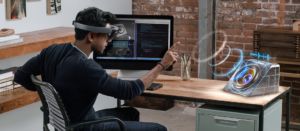Augmented Reality (AR) is set to transform many business sectors. It’s the real world, but not as we know it. It’s a kind of magic.
Close friends and technology enthusiasts, David Jeffreys and John Savage, founded Action Point in 2005. Frustrated with the standard of technology services they experienced, they set out to build a team of business and technology experts. Here, John Savage explains what Microsoft’s HoloLens is, and how it can be applied in a business environment.
What is HoloLens?
HoloLens is a new kind of interaction with computers. Microsoft will tell you that it is an untethered standalone holographic computing device. I can say it’s nothing short of magic.
In a nutshell, the HoloLens consists entirely of a unit contained in a headset. The lenses are fully transparent, allowing you to continue to see and interact with the real world unencumbered. It then allows a Holographic application that is written specifically for the HoloLens to project Holograms into the real world in a very realistic way.
A key point I would leave your readers with is that no amount of reading about it can describe it. It does have to be seen to be believed – like any good magic trick.
What are the business applications of Hololens?
The key business areas for HoloLens as Action Point sees it are:
1. Remote collaboration, such as architects working on shared models of a building before it is built.
2. Training, such as realistic human anatomy models to explore ‘physically’.
3. Real-world data visualisation, such as providing information on a factory floor to an engineer as they are working on machinery.
Action Point has already used the HoloLens for all of these scenarios.
I was in Austin, Texas and faced with a situation where I had to build a complex demonstration model of a factory, but our engineer, Grzeg, was in Ireland. I donned the HoloLens, and we used Holographic Skype to allow Grzeg to train me on the basics of building the factory and then to collaborate for nine hours as we built it.
Where do you see AR going regarding its relationship with the business world, what future applications excite you?
The way Action Point sees things, VR is a great entertainment tool that is struggling for a common business case. However, AR is the opposite. It is naturally oriented towards business applications but may struggle as an entertainment tool.
I think the remote collaboration possibilities where remote parties can share the same physical space, but virtually, are both mind-bending but hugely valuable. A key example is a junior engineer on an oil rig could use a HoloLens to allow a senior engineer to help them fix something with a very high degree of confidence while avoiding the expense and delay of physically flying out to each oil rig with a problem.
If I was a business owner reading this, what would you say to me if I wanted to ‘have a go’ and see the potential of the technology?
There is a lot of interest in the technology, and we are happy to discuss any ideas companies might have. We can help sketch out a proof of concept while also of course having a solid demonstration of the HoloLens. If you are a business owner that is interested you can find out more at actionpoint.ie/hololens.
Images courtesy of Microsoft.






